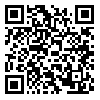Volume 10, Issue 2 (Winter 2025)
Health in Emergencies and Disasters Quarterly 2025, 10(2): 143-152 |
Back to browse issues page
Download citation:
BibTeX | RIS | EndNote | Medlars | ProCite | Reference Manager | RefWorks
Send citation to:



BibTeX | RIS | EndNote | Medlars | ProCite | Reference Manager | RefWorks
Send citation to:
Siddiqi A, Beikzad J, Nejadhaji Ali Irani F, Vedadi A. Designing a Professional Competence Model for Emergency Medical Technicians of the National Emergency Management Organization. Health in Emergencies and Disasters Quarterly 2025; 10 (2) :143-152
URL: http://hdq.uswr.ac.ir/article-1-599-en.html
URL: http://hdq.uswr.ac.ir/article-1-599-en.html
1- Department of Public Administration, Faculty of Humanities, Bonab Branch, Islamic Azad University, Bonab, Iran.
2- Department of Public Administration, Faculty of Humanities, Bonab Branch, Islamic Azad University, Bonab, Iran. ,Beikzad_jafar@yahoo.com
3- Department of Public Administration, Faculty of Humanities, Tehran Branch, Islamic Azad University, Tehran, Iran.
2- Department of Public Administration, Faculty of Humanities, Bonab Branch, Islamic Azad University, Bonab, Iran. ,
3- Department of Public Administration, Faculty of Humanities, Tehran Branch, Islamic Azad University, Tehran, Iran.
Abstract: (3089 Views)
Background: Emergency medical services (EMSs) can be considered as the health system’s main pillars. The competence of emergency medical technicians (EMTs) plays a vital role in reducing accident mortality rates. This research aims to design a professional competence model for the EMTs of the National Emergency Medical Organization (NEMO).
Materials and Methods: This is a mixed-method study. The main concepts for the model were first extracted through a literature review. Then, the opinions of 10 experts were used during three focus group discussion (FGD) sessions to localize and confirm the model. The opinions of 15 experts in accident and disaster risk management were used to measure the content validity of the model.
Results: The final model included five main themes (attribute, knowledge, skill, ability, and attitude), 11 sub-themes (physical health, mental health, professional knowledge, organizational knowledge, clinical skill, technical skill, managerial ability, cognitive ability, professional ability, individual attitude, and organizational attitude), and 47 categories. The results of the content validity test showed that the model and its items were acceptable and valid.
Conclusion: The designed model covered all domains required for the professional competence of EMTs and is a comprehensive and valid model tailored to national and international standards, which can be used as an adequate model in other countries.
Materials and Methods: This is a mixed-method study. The main concepts for the model were first extracted through a literature review. Then, the opinions of 10 experts were used during three focus group discussion (FGD) sessions to localize and confirm the model. The opinions of 15 experts in accident and disaster risk management were used to measure the content validity of the model.
Results: The final model included five main themes (attribute, knowledge, skill, ability, and attitude), 11 sub-themes (physical health, mental health, professional knowledge, organizational knowledge, clinical skill, technical skill, managerial ability, cognitive ability, professional ability, individual attitude, and organizational attitude), and 47 categories. The results of the content validity test showed that the model and its items were acceptable and valid.
Conclusion: The designed model covered all domains required for the professional competence of EMTs and is a comprehensive and valid model tailored to national and international standards, which can be used as an adequate model in other countries.
Type of article: Research |
Subject:
Emergency
Received: 2024/01/12 | Accepted: 2024/07/7 | Published: 2025/01/1
Received: 2024/01/12 | Accepted: 2024/07/7 | Published: 2025/01/1
Send email to the article author
| Rights and permissions | |
 |
This work is licensed under a Creative Commons Attribution-NonCommercial 4.0 International License. |








